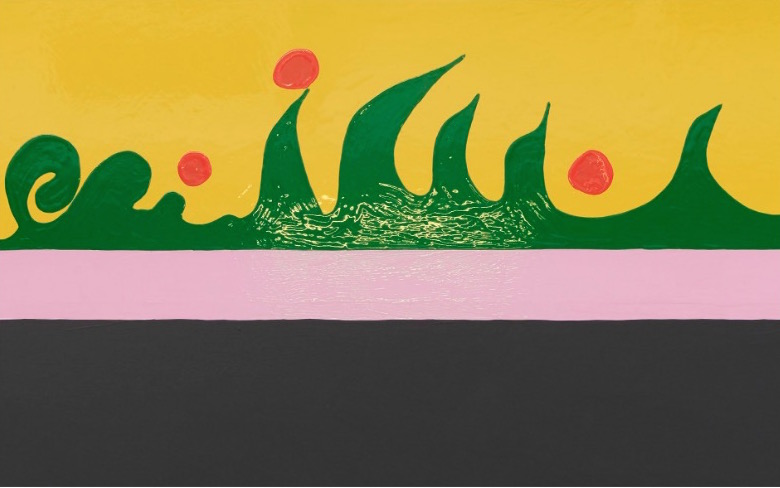In a series of new “Archipelago” works and a selection of “Destroyed School” drawings and paintings, Gary Hume’s exhibition Archipelago contends with the humanitarian crises of our present era.
The front gallery features the paintings The Blackboard and Neighbours (both 2019), alongside thirty “Destroyed School” drawings. Exhibited most recently at the Museum Dhondt-Dhaenens in Belgium (March 1—May 31, 2020), Hume’s “Destroyed School” paintings represent the artist’s response to the loss of life, hope and imagination at war-torn schools.
Over the past few years, Hume has been collecting press images of schools and classrooms destroyed or damaged by war and conflict, and the images often feature drawings by children. Hume then interprets this archive of press images in his own series of drawings and paintings.
Hume’s “Destroyed School” drawings have a sparseness and innocence characteristic of art by children, yet there is also a poignant mood of loss, or absence. Many of Hume’s drawings feature the same fragment of a flower, cut by the artist to create a shape that becomes a frame, or border. Overlaying the flower fragment on a range of other drawings, Hume creates a complex, layered image that may also convey a sense of healing, or restoration. Installed as a grid that occupies the entire wall of the front gallery, together the drawings become a history painting, a vulnerable monument to schools across the world that have been destroyed in conflict.
Over the last few years, hundreds of migrants have been making perilous journeys by boat across the Mediterranean and the English Channel. The lifejacket has become an emblem of that journey, a symbol of the mortal vulnerability of the human body. Hume has adopted this image, deploying it as an open-ended form in the “Archipelago” paintings.
“The lifejacket became a double sign for me – an iconic image of what’s described as the migrant crisis … along with a much more ancient image of the potential for life, and the celebration of life, which is a yoni.” – Gary Hume
Three “Archipelago” paintings hang in the gallery adjacent to the front gallery, creating a room where the viewer’s body is surrounded by the image of the lifejackets, and immersed in the deeply colored paintings. With both the “Destroyed School” and “Archipelago” works, Hume is asking a number of difficult questions of himself as an artist – and of the viewer. How can art, and especially pictorial art, respond directly or indirectly to historical tragedy? How do artists – and by implication, all of us – balance ethics with aesthetics?
While the shape, with its space for a neck, is clearly recognizable as a lifejacket, Hume also sees a yoni, an object that represents a procreative female energy in Hinduism, and thus the form redoubles its role as a force that can sustain a human life. The paintings are subdued and often almost uniform in color, with the lifejacket, or yonic form, faintly legible in the overlapping, interlaced lines. Yet because of the way the forms overlap, with just a few touches of contrasting color in the resulting shapes, the paintings appear mostly abstract.
Both formally and thematically the “Archipelago” paintings hearken back to Hume’s breakthrough “Door” paintings. The “Door” paintings are abstractions, alluding to the history of modernism, yet they are also identical in size and shape to the hospital doors upon which they are based. Both an art object and a human one, the “Door” paintings emerge from a similar impulse as the “Archipelago” paintings: Both represent Hume’s attempt to create a painting with abstract values such as balance and rhythm, while also grounding the work in a place of tenderness or sympathy.
Upstairs, along with three more “Archipelago” paintings in cool, almost ethereal hues, there is a sculpture and a single work on paper. Approximately life size, the lifejackets in the sculpture are stuck together in a mass, creating an abstract form reminiscent of a modernist sculpture while also evoking a pile of abandoned objects. The work on paper features an ambiguous motif full of pathos: The shape could be a child bundled up, a pupa at the edge of life, or an idealized island viewed from above. Along with the “Destroyed School” drawings downstairs, the work on paper offers a sense of fragility, a more vulnerable experience, in contrast to the sheen and hard edges of the paintings, or the bulk of the sculpture.
Gary Hume derived the title of the exhibition from a famous passage in a meditation by the English poet, and Dean of St Paul’s, John Donne (1572–1631):
No man is an island, entire of itself; every man is a piece of the continent, a part of the main; if a clod be washed away by the sea, Europe is the less, as well as if a promontory were, as well as if a manor of thy friend’s or of thine own were; any man’s death diminishes me, because I am involved in mankind, and therefore never send to know for whom the bell tolls; it tolls for thee.
Donne doesn’t use the word “archipelago,” but Hume inferred from the passage an image of interconnected islands, ideas and human life. The paintings in Archipelago are images of overlapping, intimately joined bodies, and imply the interrelatedness of all of us. Delivered just a mile away from Hume’s studio, Donne’s meditation resonates today as a timeless plea to strive for connection, not division.
| Duration | 06 October 2020 - 23 December 2020 |
| Times | Tue-Sat 11am-5pm by appointment |
| Cost | free |
| Venue | Sprüth Magers (London) |
| Address | 7A Grafton Street, London, W1S 4EJ |
| Contact | / info@spruethmagers.com / www.spruethmagers.com |

